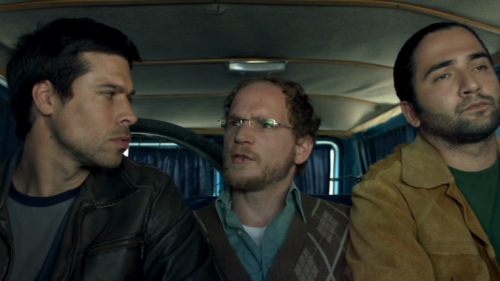FOXTROT And The Virtues Of A Non-Linear Narrative
Foxtrot tickets are on sale now. Get your tickets here!
Nolan’s Memento (2000) and Tarantino’s Palme d’Or-winning Pulp Fiction (1994) are probably the most popular examples of non-linear narrative in the film world, but non-linear narrative film is a rich subcategory that exemplifies how vastly different non-linear narratives can be. Within the subcategory lie many sub-subcategories. You have the totally warped, surrealist, avant-garde, non-linear narrative that became a significant characteristic in Italian Neorealism and the French New Wave. Films like Resnais’ Last Year at Marienbad (1961), Fellini’s 8½ (1963), and Tarkovsky’s The Mirror (1975) overlay time and place so neurotically that you’re never entirely sure when or where anything is happening. More modern examples of this bizarre, dreamlike expression of non-linear narrative include Lynch’s Mulholland Drive (2001), Caruth’s Primer (2004), and Malick’s Palme d’Or-awarded The Tree of Life (2011). All of these films express non-linearity a bit differently, but they have in common the mind-fuck mentality that acts as a magnet for any philosophy-junkie that wants to temporarily pretend they exist outside of time and space. Most expressions of non-linear narrative are much more traceable than their experimental counterparts though.
Michel Gondry’s Eternal Sunshine of the Spotless Mind (2004) bridges the gap between a clearly demarcated non-linear narrative and the surreal, experimental kind described above. A non-linear narrative can be as simple as a re-arrangement of the chronology of events. In Twelve Monkeys (1995), time is a loop. In Atonement (2007), we are given different versions of the same story, a non-linear move inspired by Kurosawa’s Rashomon (1950). In Arrival (2016), the purported past ends up being the unexpected future. Most recently, Dunkirk (2017) portrayed three stories at once in incongruent time signatures.
Which brings us to Samuel Maoz's sophomore feature Foxtrot. By the film's end, Foxtrot’s non-linearity is easily conceived, but in play, it dances back and forth through the chronology so as to narratively dizzy its viewers. Maoz builds a tricky, delicate progression that never allows the viewer to emotionally or physically unclench their tightened fists. Simply put, we never know where Foxtrot is going.
The story begins with a gut-wrenching scenario in which a family is told that their son has died in active duty. The ensuing twenty or so minutes faultlessly capture the sheer bewilderment, unquantifiable pain, and jarring existential quake that such news brings to a family, especially the parents. The mood fluctuates between deadpan satire and indescribable grief. Everyone responds differently. Some wail out of control while others attempt to be a stronghold to lean on. The camera sticks primarily with the father, Michael Feldmann (Lior Ashkenazi), as he boards an emotional roller coaster that ranges from deep internalization via speechlessness to externalized agony expressed through self-inflicted burns. Maoz showcases his technical brilliance by constantly shifting between camera angles that never give us quite enough information. How is everyone related? Who is crying in the room down the hall? How much time has passed? We might spend a whole minute zoomed in on Mr. Feldmann’s unmoving face and spend the next in a symmetrical bird’s eye view over the bathroom, the ever-changing formality complimenting the interwoven plot development.
Amidst an emotional outbreak, the Feldmann’s are revisited with even more bizarre news and we, the viewers, are transported to the son’s setting at an all but deserted military outpost where he and three other young men are responsible for checking the government-issued identification of those driving through (primarily Palestinians). After bizarre, hilarious, and tragic time spent with the four—including an isolated dance routine with an assault rifle that makes the film worth watching on its own—we start to notice that Maoz is playing with time, and, consequently, his viewers. Immediately after this realization, we are situated back with the Feldmann parents who are stumbling around like zombies, drained of all tears, exhausted beyond comprehension, and charged with conflict. It’s not clear as to how time has progressed, but something is still horribly wrong and utterly confusing. The two say things no one should ever say to their significant other as we, the viewers, try to decipher where we’ve landed on the film’s timeline. The film briefly maneuvers us into another time location before it leaves us in a pool of our own existential tears, only to capitalize on its non-narrative functionality.
Maoz does an impeccable job of fashioning a non-linear narrative that reveals just enough to keep us guessing, but not enough to ever feel confident about our guesses. Only a couple months have passed since my first viewing, but I can say without hesitation that Foxtrot strolls untouched into cinema’s non-linear hall of fame with its deadpan humor, engulfing sense of loss, technical wonder, and terrific narrative trickery. Not to mention the social and political theme over the Israel-Palestine conflict that gyrates at the film’s core—a controversial theme which elicited a government-backed boycott from Israel’s Culture Minister for its portrayal of the Israeli Defense Forces. That is an entirely different article, but it’s all the more reason for you to find this film and explore everything it has to offer.


